Geoscience Reference
In-Depth Information
those with marginal climates alternately influ-
enced by differing climatic mechanisms. Causes of
drought conditions include:
1
Increases in the size and persistence of sub-
tropical high pressure cells. The major droughts
in the African Sahel (see
Figure 13.11
) have
been attributed to an eastward and southward
expansion of the Azores anticyclone.
2
Changes in the summer monsoon circulation.
This may cause a postponement or failure of
moist tropical incursions in areas such as West
Africa or the Punjab of India. In India,
monsoon failures in the years 1965-1966, 1972
and 1987 produced the most extensive and
damaging droughts in the records for
1950-2000.
3
Anomalous lower ocean-surface temperatures
produced by changes in currents or increased
upwelling of cold waters. Rainfall in California
and Chile may be affected by such mechanisms
(see p. 377), and adequate rainfall in the
drought-prone region of northeast Brazil
appears to be strongly dependent on high sea-
surface temperatures at 0-15
Drought areas
1890s and 1930s
1910s and 1950s
Figure 4.20
Drought areas of the central USA,
based on areas receiving less than 80 percent of
the normal July-August precipitation.
Source: After Borchert (1971). Courtesy of the Association of
American Geographers.
occur in the tropics and mid-latitudes where there
is high interannual climate variability, while
droughts of 7-12 months are more frequent in
mid- to high latitudes. Droughts lasting 12
months or more are limited to the Sahel and
higher northern latitudes. Severe droughts in
northern Asia typically occur with persistent
winter anomalies of soil moisture.
From May 1975 to August 1976, parts of
northwest Europe from Sweden to western France
experienced severe drought conditions. Southern
England received less than 50 percent of average
rainfall, the most severe and prolonged drought
since records began in 1727 (
Figure 4.21
). The
immediate causes of this regime were the
establishment of a persistent blocking ridge of
high pressure over the area, displacing depression
tracks 5-10
S in the South
Atlantic. Warm ocean waters off Peru and
associated teleconnections (see pp. 375-383)
caused severe drought in Australia in
1982-1983.
4
Displacement of mid-latitude storm tracks.
This may be associated with an expansion of
the circumpolar westerlies into lower latitudes
or with the development of persistent blocking
circulation patterns in mid-latitudes (see
Figure 8.25
). It has been suggested that
droughts on the Great Plains east of the
Rockies in the 1890s and 1930s were due to
such changes in the general circulation.
However, the droughts of the 1910s and 1950s
in this area were caused by persistent high
pressure in the southeast and the northward
displacement of storm tracks (
Figure 4.20
).
°
latitude northward over the eastern
North Atlantic. Upstream, the circulation over
the North Pacific had changed earlier, with the
development of a stronger high pressure cell and
stronger upper-level westerlies, perhaps associated
with a cooler-than-average sea surface. The
westerlies were displaced northward over both the
Atlantic and the Pacific. Over Europe, the dry
conditions at the surface increased the stability of
the atmosphere, further lessening the possibility
°
From a global analysis of simulated soil mois-
ture variations, droughts of
6 months tend to







































































